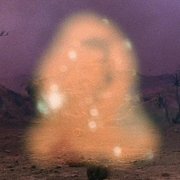plasma-based life
Plasma-based life is hypothetical life based on what is sometimes called 'the fourth state of matter,' plasma. The possibility of such noncorporeal life is a common theme in science fiction and is often entertained, for example, in episodes of Star Trek. However, it was given more credence by the announcement in September 2003 that physicists had succeeded in created blobs of plasma that can grow, replicate, and communicate, thus fulfilling most of the traditional requirements for biological cells. Lacking inherited material they cannot be described as alive, but the researchers believe these curious spheres may offer a radical new explanation for how life began.
 |
Most biologists believe living cells arose out of a complex and lengthy evolution of chemicals that took millions of years, beginning with simple molecules through amino acids, primitive proteins and finally forming an organized structure (see life, origin of). But if Mircea Sanduloviciu and his colleagues at Cuza University in Romania are right, the theory may have to be overhauled. They claim cell-like self-organization can occur in a few microseconds.
The researchers studied environmental conditions similar to those that existed on Earth before life began, when the planet was enveloped in electric storms that caused plasmas to form in the atmosphere. They inserted two electrodes into a chamber containing a low-temperature plasma of argon – a gas in which some of the atoms have been split into electrons and charged ions. They applied a high voltage to the electrodes, producing an arc of energy that flew across the gap between them, like a miniature lightning strike.
Sanduloviciu says this electric spark caused a high concentration of ions and electrons to accumulate at the positively charged electrode, which spontaneously formed spheres. Each sphere had a boundary made up of two layers – an outer layer of negatively charged electrons and an inner layer of positively charged ions. Trapped inside the boundary was an inner nucleus of gas atoms. The amount of energy in the initial spark governed their size and life span. Sanduloviciu grew spheres from a few micrometers up to three centimeters in diameter. A distinct boundary layer that confines and separates an object from its environment is one of the four main criteria generally used to define living cells. Sanduloviciu decided to find out if his cells met the other criteria: the ability to replicate, to communicate information, and to metabolize and grow. He found that the spheres could replicate by splitting into two. Under the right conditions they also got bigger, taking up neutral argon atoms and splitting them into ions and electrons to replenish their boundary layers. Finally, they could communicate information by emitting electromagnetic energy, making the atoms within other spheres vibrate at a particular frequency. The spheres are not the only self-organizing systems to meet all of these requirements. But they are the first gaseous "cells". Sanduloviciu even thinks they could have been the first cells on Earth, arising within electric storms. "The emergence of such spheres seems likely to be a prerequisite for biochemical evolution," he says.
This research raises the intriguing possibility that life throughout the universe could have a very much broader basis that normally recognized. If plasma-based life can arise naturally, places to look for it could include the outer layers or interiors of stars (see Sun, life in), planetary magnetospheres, HII regions, and even ball lightning.


